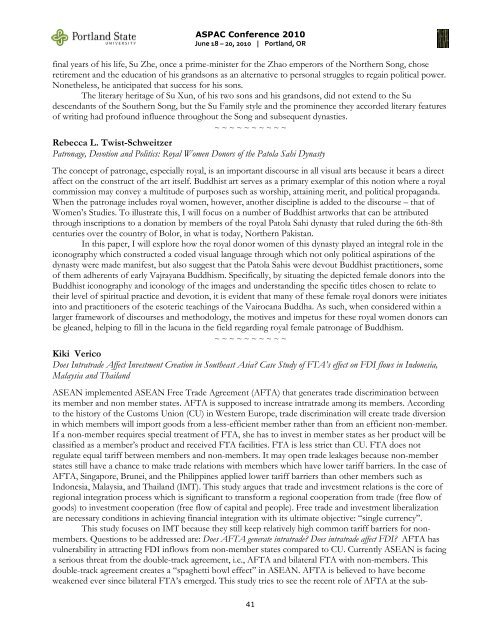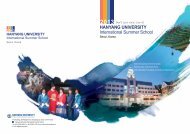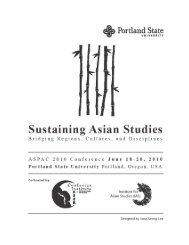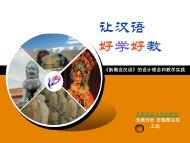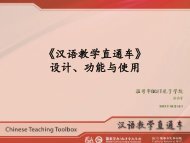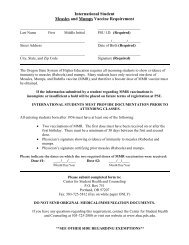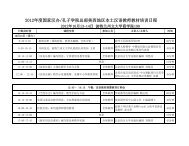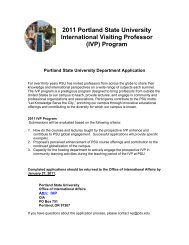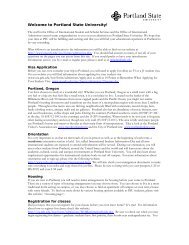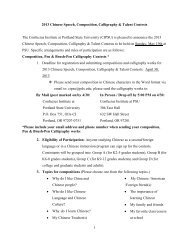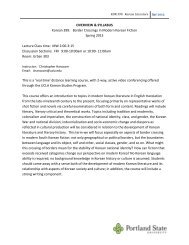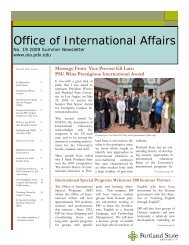ABSTRACTS - oia - Portland State University
ABSTRACTS - oia - Portland State University
ABSTRACTS - oia - Portland State University
Create successful ePaper yourself
Turn your PDF publications into a flip-book with our unique Google optimized e-Paper software.
ASPAC Conference 2010<br />
June 18 – 20, 2010 | <strong>Portland</strong>, OR<br />
final years of his life, Su Zhe, once a prime-minister for the Zhao emperors of the Northern Song, chose<br />
retirement and the education of his grandsons as an alternative to personal struggles to regain political power.<br />
Nonetheless, he anticipated that success for his sons.<br />
The literary heritage of Su Xun, of his two sons and his grandsons, did not extend to the Su<br />
descendants of the Southern Song, but the Su Family style and the prominence they accorded literary features<br />
of writing had profound influence throughout the Song and subsequent dynasties.<br />
~ ~ ~ ~ ~ ~ ~ ~ ~ ~<br />
Rebecca L. Twist-Schweitzer<br />
Patronage, Devotion and Politics: Royal Women Donors of the Patola Sahi Dynasty<br />
The concept of patronage, especially royal, is an important discourse in all visual arts because it bears a direct<br />
affect on the construct of the art itself. Buddhist art serves as a primary exemplar of this notion where a royal<br />
commission may convey a multitude of purposes such as worship, attaining merit, and political propaganda.<br />
When the patronage includes royal women, however, another discipline is added to the discourse – that of<br />
Women’s Studies. To illustrate this, I will focus on a number of Buddhist artworks that can be attributed<br />
through inscriptions to a donation by members of the royal Patola Sahi dynasty that ruled during the 6th-8th<br />
centuries over the country of Bolor, in what is today, Northern Pakistan.<br />
In this paper, I will explore how the royal donor women of this dynasty played an integral role in the<br />
iconography which constructed a coded visual language through which not only political aspirations of the<br />
dynasty were made manifest, but also suggest that the Patola Sahis were devout Buddhist practitioners, some<br />
of them adherents of early Vajrayana Buddhism. Specifically, by situating the depicted female donors into the<br />
Buddhist iconography and iconology of the images and understanding the specific titles chosen to relate to<br />
their level of spiritual practice and devotion, it is evident that many of these female royal donors were initiates<br />
into and practitioners of the esoteric teachings of the Vairocana Buddha. As such, when considered within a<br />
larger framework of discourses and methodology, the motives and impetus for these royal women donors can<br />
be gleaned, helping to fill in the lacuna in the field regarding royal female patronage of Buddhism.<br />
~ ~ ~ ~ ~ ~ ~ ~ ~ ~<br />
Kiki Verico<br />
Does Intratrade Affect Investment Creation in Southeast Asia? Case Study of FTA’s effect on FDI flows in Indonesia,<br />
Malaysia and Thailand<br />
ASEAN implemented ASEAN Free Trade Agreement (AFTA) that generates trade discrimination between<br />
its member and non member states. AFTA is supposed to increase intratrade among its members. According<br />
to the history of the Customs Union (CU) in Western Europe, trade discrimination will create trade diversion<br />
in which members will import goods from a less-efficient member rather than from an efficient non-member.<br />
If a non-member requires special treatment of FTA, she has to invest in member states as her product will be<br />
classified as a member’s product and received FTA facilities. FTA is less strict than CU. FTA does not<br />
regulate equal tariff between members and non-members. It may open trade leakages because non-member<br />
states still have a chance to make trade relations with members which have lower tariff barriers. In the case of<br />
AFTA, Singapore, Brunei, and the Philippines applied lower tariff barriers than other members such as<br />
Indonesia, Malaysia, and Thailand (IMT). This study argues that trade and investment relations is the core of<br />
regional integration process which is significant to transform a regional cooperation from trade (free flow of<br />
goods) to investment cooperation (free flow of capital and people). Free trade and investment liberalization<br />
are necessary conditions in achieving financial integration with its ultimate objective: “single currency”.<br />
This study focuses on IMT because they still keep relatively high common tariff barriers for nonmembers.<br />
Questions to be addressed are: Does AFTA generate intratrade? Does intratrade affect FDI? AFTA has<br />
vulnerability in attracting FDI inflows from non-member states compared to CU. Currently ASEAN is facing<br />
a serious threat from the double-track agreement, i.e., AFTA and bilateral FTA with non-members. This<br />
double-track agreement creates a “spaghetti bowl effect” in ASEAN. AFTA is believed to have become<br />
weakened ever since bilateral FTA’s emerged. This study tries to see the recent role of AFTA at the sub-<br />
41


